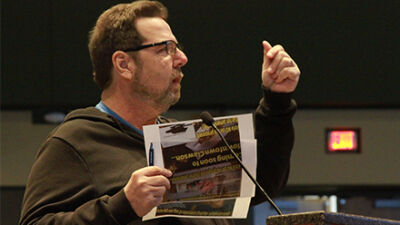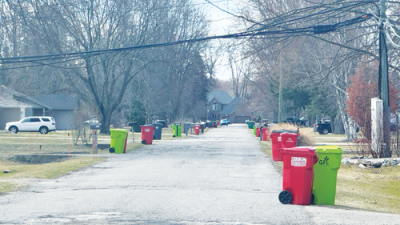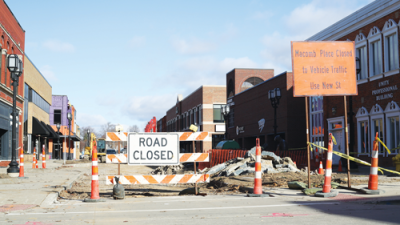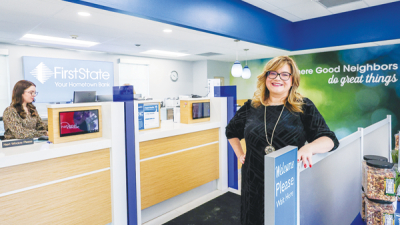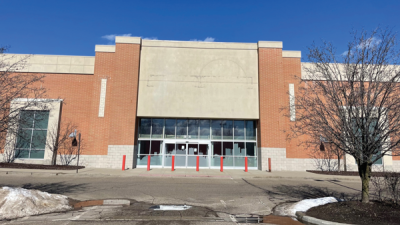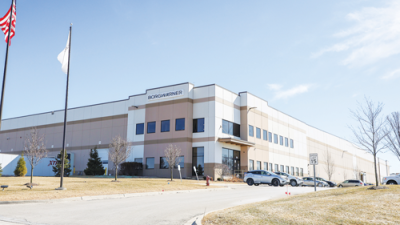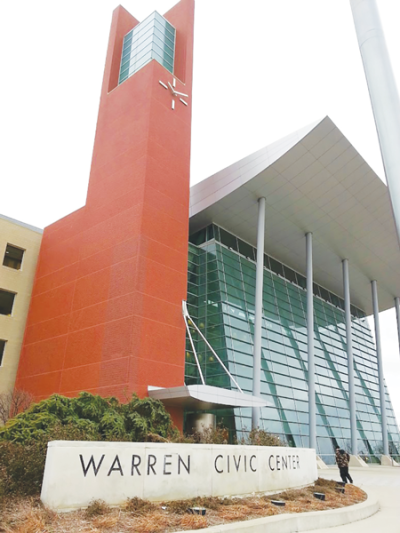
Warren Mayor Lori Stone isn’t the first mayor to take on a downtown development project. Mark Steenbergh, who was the city’s mayor from 1995-2007, said proposed development for the area dates back to 1964. Both Steenbergh and former Warren Mayor Jim Fouts advocated for the project.
File photo by Brian Louwers
WARREN — Rumblings of a downtown development in Warren have started again.
Warren Mayor Lori Stone, who was elected in 2023, wants to succeed where other administrations have failed.
“One of the struggles in the process is overcoming the inertia of what came before,” Stone said.
New plans for the Town Center Development will use parts of the 2017 plans by Gibbs Planning Group.
“I think there are changes that would be made but I think, to some degree, that’s our starting point,” City Council President Angela Rogensues said.
Stone referred to the project as a “reimagining” of the Gibbs’ plans. While it’s only a part of her greater vision for economic development in the city, Stone thought the development was “left in the air” and was something she felt she could tackle.
“It’s a great opportunity that we have right now,” Stone said. “I’m just hoping, through this process, it becomes proven to be successful, and we get to see that as part of that reinvigoration and revitalization in the community.”
Rogensues and Stone said the exact location of the downtown is still up for debate, but some of it will center around Warren’s City Hall, on Van Dyke Avenue north of 12 Mile Road. Stone said several new parcels have been added to the original location since 2017.
“It is city-owned property. It is where our city center is, but I do think there is additional conversation about what some of the other districts might look like and/or if there’s another place,” Rogensues said.
Rogensues added that residents have concerns about it being in the north of the city, when the south part of Warren is less developed.
Stone said city officials met with Gibbs Planning Group to go over the 2017 plans last year. A steering committee was then established for the project. During a presentation about options for the plan, Stone realized the community needed to be more involved. She wanted to make sure residents saw what was possible with the plans rather than just gathering a wish list from them.
“If you only have a couple people in a room and they’re going to drive this, is it really reflective of our community?” Stone said.
To get community engagement, the city held listening sessions starting last December. Stone said the meetings were attended by about 100 residents and an online survey about the development has netted around 400 responses. Once the community feedback is complete, Stone said Gibbs will take the input and incorporate it into a plan for the space.
One thing Stone heard from the feedback was that residents didn’t feel like the previous administration’s improvements, like luxury apartments and high-end restaurants, were for Warren residents.
“For community members, they thought what was being offered was unobtainable to the community,” Stone said.
There’s still time for residents to offer ideas about the development. The online survey will be available until the end of the month at www.cityofwarren.org/town-center-development-survey. Stone also encouraged residents to get involved in the next phase, which is reviewing plans. She suggested signing up for the city’s Community Alert Network system for updates about getting involved at this juncture.
In addition to commercial and residential uses, Stone wanted to make sure there were public spaces that allowed all residents to benefit from the development, citing Royal Oak and Rochester as examples of this. Stone also mentioned the downtown as being a place where people from outside the community would be drawn in.
Warren City Council Secretary Mindy Moore said Claude Molinari of Visit Detroit sat in at a steering committee meeting for the project and suggested a conference center be included in the space. This would provide Warren with a unique space in Macomb County.
“We have to have something that draws people, something different,” Moore said. “We’re not Birmingham, we’re not Royal Oak. We want to have something that’s going to draw people to us and still have a walkable downtown.”
Rogensues said the city is missing out when residents travel to other cities to dine out, go to parks and go shopping. She personally would like to see a family-owned coffee shop, grocery store, restaurants, an amphitheater and a park or sitting space.
“I think it’s really important we make sure we’re meeting the needs of our residents and that we’re keeping those tax dollars in the city,” she said.
Rogensues is eager to see a downtown development in the city.
“I definitely am in support of it and want to see a downtown development happen in my time on council,” she said. She acknowledged that the final development will be the result of collaboration.
Stone agreed that collaboration between council and the mayor is critical to make sure the project finally happens. She said council members have been present at the listening sessions, and Moore and Councilman Jonathan Lafferty are on the steering committee. Stone hopes council members bring back input from their districts to help benefit the project.
Moore said she wants a more concrete plan from the steering committee to present to residents. She said it was important to strike a balance between spaces for the public and businesses.
Rogensues said the first major step would be seeing what’s included in the plan and what investment the city would make in the project.
“I think those conversations are really important at the forefront to make sure we’re all on the same page,” Rogensues said.
Plans for ‘downtown Warren’ are not new
Warren Mayor Lori Stone isn’t the first mayor to take on the project. Mark Steenbergh, who was the city’s mayor from 1995-2007, said proposed development for the area dates back to 1964.
Under Steenbergh, portions of the project were completed in line with the original 1964 plans, including the Warren Civic Center Library and City Hall. These improvements were done with a city council-approved bond.
“We did execute some of it,” Steenbergh said.
What stalled out Steenbergh’s push for the downtown was the City Council’s opposition to installing a main street development and parking structure.
“We felt at the time, and I still feel this way, that would’ve spurred a lot more development there and a quicker development,” he said. “But the council didn’t have the appetite for that second round of bond issues, so we did not do it.”
Moore served on the City Council during Steenbergh’s administration and said the economic downturn hindered the project at the time.
Jim Fouts, who later succeeded Steenbergh as mayor, made his own attempt to push the project through. Disagreement with the City Council again halted the project. Fouts was Warren’s mayor from 2007 to 2023 and was previously on City Council from 1981 to 2007. He said the debate to get the proposal on the council agenda lasted two or three years.
“It was an infinite amount of time with no real good justification for it not being on the agenda,” Fouts said. “At the time we kept arguing that time was of the essence with inflation and things the cost was going to go up.”
He said a public meeting was held and Fouts brought experts in to extoll the benefits of the development.
“Then the council decided they didn’t want to hear it from them, they wanted a written explanation not an oral (explanation),” Fouts said. “I said, ‘Why? We’ve got these experts here. Why not ask them questions and let them give you a presentation?’ And they refused to do it.”
Following the back and forth, Fouts said he wasn’t sure if the issue was hostility to him or the project itself.
“Regardless, it was very disappointing,” he said. “It was a good project. I pointed out to them it would generate $2 million to $4 million of new tax revenue every year. We have studies that showed it would generate new business investment in Warren.”
Moore, who was on the City Council at the time, said council members didn’t act on the project because of a lack of transparency and not enough spaces for public use.
“His plan was giving a developer $30 million with no strings attached,” Moore said. “Didn’t have to pay it back. The (downtown development) authority didn’t have any ownership. They were going to get nothing out of that $30 million.”
Moore said data for the project was outdated and incomplete. Also, when the council contacted the entities that Fouts said were interested in investing, they were met with confusion.
Council wanted a letter of agreement from those interested, which she said the mayor declined to do unless council voted in favor of the development.
“That would be absolutely frivolous on our part to do something like that,” Moore said.
Fouts said the development would keep residents from spending their money outside the city. It could’ve also drawn in new businesses to the city.
“It was worth millions of dollars in new business, millions of dollars in people staying in Warren and not moving out,” Fouts said.
He went on to say not getting the project through was one of his “greatest regrets.”
Both former mayors agree that it will take a unified effort from the mayor and the council to make the downtown development a reality.
“The council controls the money, and the mayor tries to put forward the leadership to do it,” Steenbergh said. “There has to be cooperation to get it done.”
 Publication select ▼
Publication select ▼














